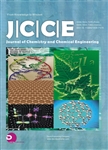Natural Composite Material from Steelwool or Luffa cylindrica under Natural, Rigid and Flexible Resin
Natural Composite Material from Steelwool or Luffa cylindrica under Natural, Rigid and Flexible Resin作者机构:Doctor Chemical Engineering Autonomous University of Sinaloa Culiacan Rosales 80040 Mexico Industrial Designer Master (C) in Materials and Process Engineering National University of Colombia Bogota 11001 Colombia Chemical Engineering and Mechanical Master in Environmental Engineering PhD in Chemical Engineering National Universityof Colombia Bogota 11001 Colombia Chemical Engineering (C) National University of Colombia Bogota 11001 Colombia Industrial Designer Master of lnformation Technology Central Queensland University Rockhampton QLD 4702 Australia
出 版 物:《Journal of Chemistry and Chemical Engineering》 (化学与化工(英文版))
年 卷 期:2014年第8卷第9期
页 面:906-917页
学科分类:08[工学] 0805[工学-材料科学与工程(可授工学、理学学位)] 080502[工学-材料学]
主 题:Natural fibers steelwool industrial design binder matrix composite materials reinforced polymer.
摘 要:In a changing world with a high interest in new ecomaterials, natural fibers such as the steelwool or Luffa cylindriea appear in new presentations and mixing with other materials to develop better opportunities to replace synthetic fibers. This work presents a research on the use of steelwool fiber for composite materials, on the basis of the physical properties, that generate conditions of mixing with three binders (matrix) natural: the rosin, artificial hard: polyurethane resin and artificial flexible: flexible twin resin (epoxy) and finally a polyester resin to make a comparison with other major resins. A testing of compression and tension is carried out to the materials analyzed, obtaining three types of composite materials by the above mentioned binders and three proposed presentations of fiber (complete, tissue and ground). The test tube in tension with polyester resin presented a high rigidity and a percentage of deformation of 14%, resulting in less distortion than the woven with resin polyurethane with 12% of deformation. The presentation with resin polyurethane presented greater resistance to compression, because the resin acts as a sponge absorbing the energy of charge and the join of particles is larger than the other presentations generating greater cohesion among them and avoiding its rupture easily for a load of 2,000 kg. The presentation that is least resisted was the woven in two resins in the stage of energy absorption of load where polyurethane is 800 kg and the flexible twin is 850 kg, because the form of woven fiber distribution creates spaces where there are more resin than fiber.



